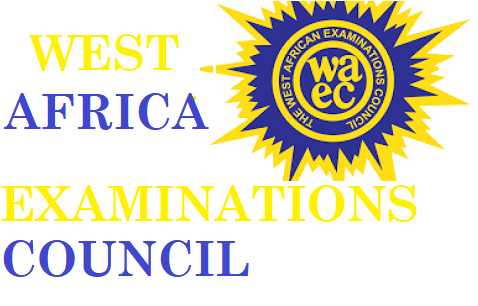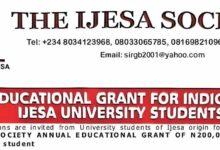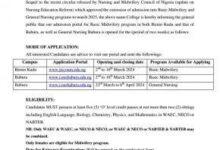
WAEC Syllabus for Crop Husbandry and Horticulture
WAEC Syllabus for Crop Husbandry And Horticulture. WAEC Syllabus for Crop Husbandry And Horticulture is available for all candidates who want to participate in the examination. The West African examination council (WAEC) has officially introduced a syllabus that will guide all the WAEC candidates who wish to write the WAEC examination this year. For a very successful WAEC Crop Husbandry And Horticulture examination for this year, you need to check out the available areas of concentration. It has been divided into sections with chapters, followed by the topics to be covered in preparation for the exams. In the WAEC Syllabus for Crop Husbandry And Horticulture, you will also see the format of how the WAEC Crop Husbandry And Horticulture questions will be presented. Jamb form
There are always 3 sections to answer questions from. Paper 1 is Objective questions, paper 2 is essay questions and then paper 3 is practical’s. Where paper one (1) carries 1 hour for 50 marks, paper two (2) carries 2 hours for 80 marks while paper three (3) carries 2 hours for 60 marks.
👉 Relocate to Canada Today!
Live, Study and Work in Canada. No Payment is Required! Hurry Now click here to Apply >> Immigrate to Canada
This WAEC syllabus is for both the O’level WAEC and General Certificate Examination (GCE) candidates. Final year students in the senior secondary school level and external candidates are eligible to make use of this syllabus and prepare ahead of the examination.
See the full detailed information concerning the WAEC Crop Husbandry And Horticulture Syllabus below.
PREAMBLE
The examination syllabus has been structured, based on the teaching syllabus, to assess candidates knowledge and skills in the production, processing, storage, marketing and uses of arable, plantation and horticultural crops. It will also assess the knowledge and skills of candidates in landscaping and other vocations in crop husbandry.
AIMS OF THE SYLLABUS
The syllabus is designed to provide a comprehensive assessment of candidates’ knowledge and skills in relation to: WAEC Syllabus for Crop Husbandry And Horticulture
(1) the factors that affect crop production;
(2) the botany of various arable, plantation and horticultural crops;
(3) the propagation and cultivation of various arable, plantation and horticultural crops;
👉 Relocate to Canada Today!
Live, Study and Work in Canada. No Payment is Required! Hurry Now click here to Apply >> Immigrate to Canada(4) the effective management of crop-based enterprises;
(5) the processing, preservation, storage, transportation, marketing and use of crops;
(6) the management of basic problems associated with crop cultivation;
(7) landscaping, home gardening and interior decoration;
(8) the socio-economic importance of crops.
REQUIREMENTS
(1) Schools offering Crop Husbandry and Horticulture are expected to keep farms and compounds or attach students to established farms where a variety of arable and horticultural crops are grown and maintained.
(2) It is recommended that schools should have laboratories, workshops, farm tools and equipment, and study materials such as specimens, chemicals and seeds.
(3) It is also recommended that candidates keep practical notebooks, farm diaries and weed albums. These should contain records of individual activities, based on laboratory and field observations. Waec Result
EXAMINATION SCHEME
There will be three papers, Papers 1, 2 and 3 all of which must be taken. Papers 1 and 2 will be a composite paper to be taken at one sitting.
PAPER 1: Will consist of fifty multiple-choice objective questions all of which must be answered within 1 hour for 50 marks.
PAPER 2: Will consist of six essay-type questions. Candidates will be required to answer four questions within 2 hours for 80 marks.
PAPER 3: Will be a practical paper for school candidates or alternative to practical test paper for private candidates. Each version will consist of four questions all Npower Recruitment
of which must be answered within 2 hours for 60 marks.
DETAILED SYLLABUS
| CONTENTS
|
NOTES
|
| A. CULTIVATION OF
FIELD CROPS 1. Factors affecting crop production. 2. Characteristics and importance of field crops.
3. Distribution of field crops in West Africa. 4. Breeding of field crops: (a) Selection of good planting material. (b) Techniques for developing and maintaining improved varieties.
(c) Seed production and marketing. 5. Production of cereal crops: (a) Classification, botanical attributes and distribution of cereal crops in West Africa.
(b) Land preparation, planting, cultural practices.
(c) Harvesting, processing and storage.
(d) Uses, value chains and marketing. 6. Production of leguminous crops: (a) Classification, botanical attributes and distribution of leguminous crops in West Africa.
(b) Land preparation, planting and cultural practices.
(c) Harvesting, processing and storage. (d) Uses, value chains and marketing.
7. Production of root and tuber crops:
(a) Introduction
(b) Climatic and soil requirements.
(c) Land preparation, planting and cultural practices.
(d) Harvesting,post- harvest handling and uses.
8. Production of cotton:
(a) Introduction
(b) Land preparation, sowing and cultural practices
(c) Harvesting and processing
9. Prodction of sugarcane:
(a) Introduction
(b) Land preparation, planting and cultural practices.
(c) Harvesting
(d) Processing and Uses
10. Cultivation of fruit crops: (a) Types,characteristics and geographical distribution of fruit crops in West Africa.
(b) Land preparation and nursery practices.
(c) Transplanting and field maintenance.
(d) Harvesting and post-harvest handling.
(e) Marketing
11. Production of Tree crops: (a) Types, characteristics, classification and importance of tree crops.
(b) Geographical distribution, environmental requirements and adaptations
(c) Seed dormancy
(d) Land preparation and techniques of raising and management of tree crops.
(e) Harvesting and post-harvest handling.
(f) Marketing
12. Production of specific tree crops: (a) Classification, botanical attributes and distribution of specific tree crops in West Africa.
(b) Land preparation, planting and cultural practices.
(c) Harvesting, processing and storage.
(d) Uses, value chains and marketing.
B. PRODUCTION OF VEGETABLES (a) Types, characteristics, nutritional and economic importance.
(b) Production systems and cropping patterns of vegetable crops in West Africa.
(c) Environmental requirements.
(d) Site selection and land preparation.
(e) Nursery and field practices.
(f) Harvesting and post-harvest handling of vegetable crops.
(g) Quality and safety standards in vegetable production.
(h) Vegetable seed production and marketing.
C. PRODUCTION OF SPECIFIC VEGETABLE CROPS (a) Classification, types, environmental requirements and land preparation methods. (b) Nursery and cultural practices.
(c) Harvesting and post-harvest handling.
(d) Quality and safety standards invegetable production and roles of actors and players.
D. RAISING ORNAMENTAL PLANTS (a) Types and functions of ornamental plants. (b) Propagation of ornamental plants.
(c) House plants: (i) Types and uses
(ii) Selecting houseplants for specific uses. (iii) Management of house plants: Tools, Containers and Management, practices.
(iv) Marketing (d) Establishment and management of lawn grasses.
(e) Establishment and management of hedges.
(f) Establishment and management of beds and borders.
E. LANDSCAPING
(a) Meaning and importance of landscaping.
(b) Components and principles of landscape design.
F. VOCATIONS IN CROP HUSBANDRY AND HORTICULTURE (a) Vocations and tasks in Crop Husbandry and Horticulture.
(b) Role of vocations (c) Establishments of enterprises
|
The effects of solar radiation, temperature, rainfall,wind, edaphic, biotic, and inorganic elements on crop growth, development and yield is required.
Understanding of the term field crops, knowledge of their characteristics, knowledge of the common and scientific names of common field crops, and classification of field crops based on the uses and life cycles are required.
The groups based on uses are as follows: Staple food crops 1. Cereals (maize, rice, sorghum, millet, wheat, etc.) 2. Grain legumes (cowpea, groundnut, bambara groundnut, soya bean, lima bean, pigeon pea, broad bean, jack bean, sword bean, winged bean, etc.) 3. Root and tuber crops (cassava, sweet potato, yam, cocoyam, Irish potato), and 4. Plantains.
Special purpose field crops 1. Fibre crops (cotton, jute, kenaf, roselle, sisal hemp) 2. Spice crops (ginger, black pepper) 3. Sugar crops (sugar cane) 4. Oil crops (sunflower) 5. Medicinal crops (moringa, aloe) 6. Aromatic crops (citronella, lemon grass) 7. Fumitories (tobacco) 8. Masticatories (tiger nut) The groups based on life cycle are Annuals, Biennials, and Perennials. Dollar to Naira Rate
The effects of climatic, soil, socio-cultural and biological factors on the distribution of field crops is required.
Knowledge of the characteristics and sources of good planting materials such as seeds and vegetative materials is required.
Methods of crop improvement such as introduction, selection and hybridization and techniques for maintaining improved varieties are required.
Factors influencing seed production, methods of seed production, processing, storage and marketing, qualities of good seed, and factors affecting seed viability are required. Jamb Result
The major types of cereal crops (maize, millet, sorghum, and rice), their geographical distribution in West Africa, their classification (family, genus, species and varieties), the morphological characteristics of the roots, leaves, flowers and seeds, and the cross-sectional parts of seeds is required.
Land preparation activities, sowing/transplanting and cultural practices like supplying, thinning, weeding, irrigation, fertilizer application, pests and diseases and their control will be assessed.
NB: Knowledge of the life cycle of the stem borer (Busseolafusca) is required.
Knowledge of signs of maturity, harvesting, processing for storage and methods of storage will be assessed.
The uses of cereals; and importance of value chains in the production and marketing of cereals will be assessed. Pounds to Naira
The major types of leguminous crops (cowpea, groundnut and soya bean), their geographical distribution in West Africa, their classification (family, genus, species and varieties) will be assessed.
Skills in land preparation, sowing/transplanting and cultural practices like seed selection and sowing, supplying, thinning, weeding, fertilizer application, pests and diseases and their control will be assessed.
NB: Knowledge of the life cycle of the bruchid (Callosobruchusmaculatus) is required. Signs of maturity, harvesting, processing for storage and methods of storage will be assessed.
The uses of legumes; and importance of value chains in the production and marketing of legumes will be assessed.
Differences between root and tuber crops, their morphological and anatomical features with emphasis on the storage organs, classification (family, genus and species) varieties and cultivars of cassava and sweet potato and the different species of yams and cocoyam is required. The species of yam to be considered are as listed below:
Species of yam: Dioscorearotundata (Guinea yam) Dioscoreaalata (Water yam) Dioscoreacayenensis (Yellow yam) Dioscoreadumentorum (Bitter yam) Dioscoreaesculenta (Chinese yam/Trifoliate yam) Dioscoreabulbifera (Aerial yam) Dioscoreapraehensilis (Bush yam) Species of cocoyam Xanthosomasaggitifolium (Tania) Colocassiaesculenta (Taro)
The climatic and soil requirements for growing the root and tuber crops will be assessed.
Method of land preparation i.e. slash and burn, mounding, ridging etc., the planting materials (stem/vines, cuttings, setts, minisetts, microsetts, bulbils, suckers, tissue culture, plantlets etc.), and the techniques for producing the various planting materials for root and tuber crops are required.
Recommended spacing and correct orientation of planting materials, cultural practices such as staking and training, remounding, weeding, fertilizer application, diseases and pests and their control are also required.
Signs of maturity , methods of harvesting such as double and piece meal harvesting and harvesting precautions, post-havest handling suc as preservation, storage methods, processing and various uses will be assessed.
Assessment will cover classification (from family to species), morphological features (root, leaf, stem, fruit and seed) climatic, soil requirement and distribution of cotton in West Africa.
Assessment will cover methods of land preparation and cultural practices such as ploughing, irrigation, pests and diseases and their control.
Knowledge of the life cycle of the cotton stainer(Dysdercusspp). and how it can be used to formulate control measures will be required.
Harvesting and processing activities (ginning and grading) will be assessed. Knowledge of the different species (Saccharumofficinarum, Saccharumbarberi, Saccharmsinense, Saccharumedula), their morphological characteristics and botanical classification (family, genus, species) and the soil, rainfall and water requirements will be assessed.
Land preparation methods such as clearing, ploughing, harrowing and ridging will be assessed. Propagating materials (short setts, long setts and soldier setts), planting space, and cultural practices such as weed control,earthing-up, fertilizer application and the identification of the major factors that affect the quality of cane will be assessed.
Knowledge of signs of maturity, optimum harvesting time, method of harvesting, frequency of harvesting (ratoon) and the various stages of sugar cane extraction will be assessed.
Description of the processing stages (crushing/milling, clarification, concentration, crystallization and refining) and precautions to ensure maximum sugar yield during extraction are required.
Knowledge of the uses of products and by-products of sugar are also required
Knowledge of botanical names of various types of tropical and sub-tropical fruits is required. This will include citrus, pineapple, mango, banana, avocado pear, pawpaw, shea, miraculous berry, hog plum, apple, grapes etc. Assessment will also cover knowledge of the characteristics, the environmental requirements and geographical distribution of fruit crops in West Africa.
Assessment will be on knowledge and understanding of land preparation methods, pre-nursery and nursery practices such as budding, grafting, potting, soil sterilization, shading, roguing, hardening, fertilizer application, pest and disease control, irrigation etc.
Cultural practices in the field such as transplanting methods and processes e.g. lining and pegging, planting pattern, planting at stake and transplanting etc, and field care such as fertilizer application, mulching, weed control, pests and diseases and their control will be assessed.
Signs of maturity, method of harvesting, precautions, equipment for harvesting, post-harvest handling e. g. sorting, grading and packaging; pests and diseases and their control will be assessed.
Candidates will be assessed on marketing channels, quality and safety standards. The importance of value chains in the production and marketing of fruit crops will also be assessed.
The types (based on their uses), scientific names and botanical characteristics is required.
The geographical distribution in West Africa and the adaptations of various tree crops is required. Causes of seed dormancy and methods to break dormancy will be assessed.
Assessment will be on land preparation methods, pre-nursery and nursery practices such as budding, grafting, potting, soil sterilization, shading, weed management, mulching, shading, roguing, fertilizer application, pest and disease control, irrigation etc.
Signs of maturity, methods of harvesting, precautions, equipment for harvesting, pests and diseases and their control; Post-harvest activities such as dehusking, hulling, fermentation, canning, drying, coagulation, smoking etc. will be assessed.
Candidates will be assessed on marketing channels, quality and safety standards.
The major types of tree crops (cocoa, cashew, coconut and oil palm), their geographical distribution in West Africa, their classification (family, genus, species and varieties); morphological characteristics of the roots, leaves, flowers and seeds, and the cross-sectional parts of seeds will be assessed. Land preparation, nursery practices, planting methods and patterns, cultural practices, pests (including the life cycle of cocoa capisds/ mirids) and diseases and their control will be assessed.
Signs of maturity, harvesting tools and steps in using the tools, harvesting, handling procedures, grading, processing of each tree crop produce into industrial products and storage method(s) will be assessed.
The uses, nutritional and economic importance, tree crop value chains and the quality and safety standards for marketing in the tree crop industry is required. Assessment will cover knowledge of the various types of vegetable crops (based on uses and life cycle) and their characteristics. Scientific names of vegetables including cabbage, African spinach, Indian spinach, cocoyam, lettuce, talinum, cauliflower, tomatoes, pepper, garden eggs, cucumber, water melon, okro, sweet pepper, French beans, agushi, lima bean, shallot, onion, carrot and radish will be assessed. Skills in making biological drawings of economic parts of vegetables and knowledge of the nutritional and socio-economic importance of vegetables will be assessed.
Features and skills required in the various types of vegetable production systems (backyard garden/home garden, market garden, truck farming, production for processing, irrigated vegetable farming, dry season farming, vegetable seed production and hydronics gardening) will be assessed.
Assessment will also be based on various cropping patterns which include crop rotation, inter-cropping, succession cropping, relay cropping and phased cropping as well as advantages and disadvantages of each pattern.
The climatic and soil factors is required.
Assessment will be based on the criteria for site selection for vegetable enterprise and skills for developing vegetable crop farms, land preparation methods (raised and sunken beds, ridges and flat), the merits and demerits of various land preparation methods and justification for the methods selected.
Reasons for and skills in undertaking nursery practices such as seed box/bed preparation including soil sterilization, drilling, pricking out, hardening off, transplanting, etc and field practices including supplying, watering/irrigation, thinning, mulching, staking, weed management, fertilizer application, pruning, pest and disease control will be assessed.
The signs of maturity, equipment used for harvesting, precautions, methods and skills used in harvesting and post-harvest handling such as trimming, washing, removal of malformed and damaged vegetables, grading etc. Knowledge preservation and processing methods such as drying, curing, milling, pasteurization, refrigeration, pickling, canning etc. will be assessed.
Assessment will be based on the procedures and skills in maintaining food quality and safety standards – external quality: shelf life, appearance -colour, shape etc, and internal quality: taste, nutritive value etc.
The various methods of extraction and storage of seeds of pulpy fruits and dry fruits; labelling, pricing etc. and marketing will be assessed.
Assessment will be on classification of tomato, cabbage, carrot, French bean, lettuce and cauliflower into family, genus, species, varieties and cultivars. Types of vegetables based on botany; (i) Leafy vegetables – cabbage and lettuce;(ii) Floral vegetables – cauliflower; (iii) Fruit vegetables – tomatoes, pepper, garden eggs, okro; (iv) Pod and seed vegetables – French beans and agushi, (melon seed) and (v) Vegetables with fleshy storage structures – onion and carrot. The environmental requirements and land preparation methods, nursery practices (if applicable), spacing, transplanting/planting methods for individual crops will be examined.
Assessment will be based on knowledge and skills in planning and carrying out all the required nursery and cultural practices such as bed preparation and soil sterilization, seed drilling, irrigation/watering, shading, mulching, and transplanting, fertilizer application etc.
Candidates will be assessed on the signs of maturity, equipment used forharvesting, precautions and skills in methods used in harvesting and post-harvest handling of each vegetable (fresh or dried). Knowledge and understanding of parameters and procedures for yield determination will also be assessed.
Assessment will be based on how quality and safety standards are to be maintained e.g. grading, packaging, transporting to local markets and factors to be considered in pricing harvested vegetable products etc.
Assessment will also be based on value chains in vegetable production, the roles of various actors/players in the supply of vegetables, description of marketing procedures of a vegetable crop in a local market and a foreign market (e.g. European market).
Knowledge of the types of ornamental plants based on their uses and growth habits i.e. Outdoor plants (grouped into bedding plants, shrub plants, climbing plants, ground cover and water plants); and Indoor plants, will be assessed. The scientific names and functions of ornamental plants will also be assessed.
Candidates will be assessed on of the methods of propagation by seeds and vegetative means, media and containers for propagation.and also collection, purification and cleaning and maintenance of seed viability; and nursing or planting at stake.
Knowledge of the types of house plants based on the morphological features and position in the house is required.
Assessment will be based the selection and placement of house plants and containers.
The uses of tools, containers and management practices such as provision of light, air, water, fertilizer application; pruning and trimming; pest and disease control, cleaning and polishing will be required
Assessment will be based the factors of production, demand and supply, packaging, pricing and transport.
Assessment will be based on knowledge of the characteristics and importance of lawns, planting materials, methods of propagation, common lawn grasses, site preparation and maintenance practices such as watering, weeding and spiking.
Assessment will be based on common hedging plants and their characteristics; the importance of hedges, planting materials, methods of propagation, site preparation and maintenance practices such as watering, weeding andpruning.
Assessment will be based on knowledge of common bed and border plants, the differences between beds and borders and hedges and borders; principles underlying establishing beds and borders; Management practices including selection of appropriate plants for beds and borders, planting materials, methods of propagation, common bed and border plants and site preparation and maintenance practices such as watering, weeding and pruning.
Knowledge and understanding of the concept and importance of landscaping (conservation, beautification, screening, forest reserve/green belt and wind break) are required.
The differences between the components and the roles of the components (materials) such as landform, plant materials, water, sculpture and stone work, garden boundaries and ground pattern will be assessed.
Knowledge and understanding of the principles of design (unity, scale, time, space division, texture, light and shade, tone and colour, style, line, variety, balance, repetition, balance, emphasis etc.) will be assessed.
Assessment will be based on knowledge of vocations available in Crop Husbandry and Horticulture and the tasks involved. Tasks in occupations such as Produce Marketing, Exporting, Importing, Providing Services and Supplies, etc taking into consideration the educational qualifications, training, resources etc required to perform the tasks; and the benefits derived from the jobs.
Candidates will be assessed on their ability to discuss the importance of vocations to the individual, community and nation.
Candidates will be assessed on their ability to analyze the factors, resources and procedures (development of a business plan, registration of business etc.) required to establish enterprises.
|
PRACTICAL SYLLABUS
| CONTENTS | NOTES
|
| 1. Introduction to Crop
Production
2. Nursery Practices
3. Field Practices (a) Land preparation and Planting
(b) Fertilizers (c) Weeds
(d) Pests and Diseases
(e) Irrigation
4. Harvesting and Post-harvest Handling 5. Record keeping 6. Landscaping and Ornamental Horticulture
|
Ability to identify, classify and make biological diagrams of parts and sections of and of whole plants is required.
Knowledge of use of field crops, vegetables, fruit of crops, tree crops and ornamental plant is required.
Ability to identify farm tools and equipment, and knowledge of the uses and maintenance of general and specialized farm tools and equipment are also required.
Ability to determine soil physical properties e.g. structure, texture: and chemical properties e.g. pH, salinity are required.
Ability to identify and prepare containers and media for propagation and knowledge of methods of propagation including budding and grafting are required.
Ability to carry out seed tests such as germination, health and purity tests; undertake practices such as drilling, broadcasting, sowing, pricking out, thinning, application of pesticides and starter solutions, hardening off and transplanting are required.
Knowledge of types of seed beds; seed rate, planting materials, planting methods and cropping calendar is required. Ability to calculate and interpret data on spacing and plant density is required.
Types of fertilizer and methods of application of organic and inorganic fertilizers e.g. granules, foliar,banding and broadcasting is required.
Identification of weeds, their ecological adaptations, and weed control measures e.g. cover cropping, mulching, herbicide application (types of herbicides) etc. is required.
Ability to identify pests and diseases; symptoms and effects of disease on host; life cycle of economic insects e.g. stem borer; Control measures for pests and diseases, including calibration of spraying equipment, types of pesticides and pesticide formulation are required.
Types, uses and maintenance of irrigation equipment and parts e.g. watering can, watering hose, sprinklers, laterals and water pump is required.
Signs of maturity; methods of harvesting, seed extraction, processing and storage; grading of produce and products of arable, plantation and horticultural crops and the ability to estimate yield of crops are required.
Knowledge of types and uses of farm records; and ability to take/keep records on the farm are required.
Knowledge of various components used for designing landscape; Identification of ornamental plants, and their uses; knowledge and skills in the use of tools, equipment, containers, media, etc for ornamental horticulture are required.
|
Check and Confirm: How much is Dollar to Naira Pounds to Naira Rate Today







